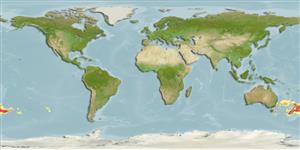Pycnogonida |
Pantopoda |
Pycnogonidae
Environment: milieu / climate zone / пределы глубины / distribution range
экология
. Subtropical
Southwest Peninsula: New Zealand.
Length at first maturity / Size / Weight / Возраст
половая зрелость: Lm ? range ? - ? cm
Trunk ovoid with very short lateral processes. Trunk with three low dorsomedian bulges. Proboscis a plain, slightly inflated cylinder tapering distally to small mouth area. Abdomen short, laterally inflated. Ovigers entirely lacking in both sexes. Legs very robust, coxae shorter than their diameters, femur with proximoventral bulge and dorsodistal knob and bulge. Second tibia only slightly longer than the width. Tarsus triangular, with few sole spines. Propodus well-curved, wider at base than distally, with only distal sole spines, claw very robust, about 0.6 of propodal length. Without auxiliary claws. It cannot be predicted with any certainty whether or not this species has male ovigers, but if not, it joins the other species in this genus which have auxiliary claws, however small, and these must serve to separate these two otherwise similar members of the New Zealand fauna (Ref. 9).
Depth estimate based on Family (Ref. 9).
Life cycle and mating behavior
половая зрелость | размножение | нерест | Eggs | Fecundity | Larvae
Members of the class Pycnogonida are gonochoric and sexually dimorphic. During copulation, male usually suspends itself beneath the female. Fertilization occurs as the eggs leave the female's ovigers. Males brood the egg masses until they hatch. Life cycle: Eggs hatch into protonymphon larva then to adults.
Основная ссылка
ссылки | координатор | соавторы
Child, C.A. 1998 The marine fauna of New Zealand: Pycnogonida (sea spiders). NIWA Biodiversity Memoire 109. National Institute of Water and Atmospheric Research (NIWA). Washington, D.C. 20530, USA. 71 p. + Figure 2A-G, 3A-F, 4, 5. (ссылка 9)
Статус Красного Списка МСОП
(ссылка 130435: Version 2025-1)
Статус СИТЕС (ссылка 108899)
Not Evaluated
CMS (ссылка 116361)
Not Evaluated
Угроза для людей
Использование человеком
| FishSource |
инструменты
дополнительная информация
Trophic EcologyFood items (preys)
состав пищи
потребление пищи
хищники
Population dynamicsрост
Max. ages / sizes
Length-weight rel.
Length-length rel.
Размерный состав
Mass conversion
численность
Life cycleразмножениеполовая зрелостьFecundityнерестEggsРазвитие икрыLarvae PhysiologyOxygen consumption
Human RelatedStamps, coins, misc.
ресурсы в Интернет
Estimates based on models
Категория цены
Unknown.
